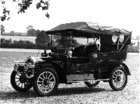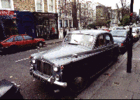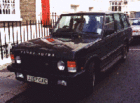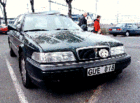Rover history
The beginning
James Starley and Josiah Turner started the Coventry Sewing Machine Company in 1861. They planned to take advantage of the watch making skills of the people in Coventry in the manufacture of their sewing machines. It is probable that the sewing machine business was not very good because in 1869 the company was renamed the Coventry Machinists Company and production was changed to cycles. The first cycles produced were affectionately named "boneshakers".
In 1870, Starley formed a partnership with William Hillman (who later started his own business producing both cycles and automobiles). At this point James Starley's nephew, John Starley, was engaged by the firm and together these three started to build Ariel cycles.
Starley in William

John Starley worked for a few years with his uncle but in 1877 he started a new business with a local cycling enthusiast, William Sutton. They produced both bicycles and tricycles with great success. John Starley realised that easy personal transportation would liberate the individual's ability to rove around the country and commencing in 1884 he named all cycles from their factory "Rover".
In 1885 Starley constructed The Rover Safety Bicycle which was an immediate success and it became the model on which all bicycles of the time were based - and still is. During the first year of production the Safety Bicycle was exported to all continents around the world.
Starley now started experiments with battery powered cycles but at the time - as is still the case today - the capacity of the batteries was too low.
By this time the Rover label had become so well known that the company changed its name to the Rover Cycle Company Limited.
Fast development

John Starley died suddenly in 1901 and was succeeded as Managing Director by Harry Smith. Smith's, first decision was for the company to commence building motorcycles and in 1901 the first model was released. It was called The
Imperial Rover and was equipped with a 2.5 hp engine.
One year later the company decided to build cars. Edmund Lewis was recruited from Daimler and in less than six months he managed to build a prototype. The car had a two seat coach and an 8 hp engine. The coach was built by Hawkins and Peake and the price of this car was £200 when it reached market at the end of 1904.
In 1905, as cars became more important, the production of motorcycles ceased and the company changed its name to the Rover Company Limited. Also in 1905 a new smaller car was introduced. This one had a 6 hp engine with a capacity of 780 cc This model became very popular under the name a one guinea car - so it really was a low cost car! This model was produced until 1912.
To the top!
The winner!

The next step taken by Edmund Lewis was the rapid development of two bigger models. First a 10/12 hp model and then a model with a 16/20 hp engine. The 16/20 became known as the Silent and Speedy. It was equipped with improved suspension, a steering-column gear shift and initially a 3119 cc engine which was subsequently increased to 3251 cc. In 1907, one of these cars was entered in the RAC rally held on the Isle of Man. It was the winner of the contest and " The International Tourist Trophy ". The factory-driver, Ernest Courtis was awarded a gold watch and given an extra weeks' holiday for his victory.
In 1910, Edmund Lewis was contracted by the rival company Armstrong Siddeley. Rover then engaged Owen Clegg as Head of Design and Manufacturing, Clegg only worked for Rover for 18 months but his influence lasted for a whole decade. Clegg constructed the famous 12 hp engine that was introduced along with a new car model in 1911. This car and engine were the main products up to World War I.
In 1911 Rover started to produce motorcycles again. A model with a 3.5 hp engine became very popular.
To the top!
Ambulances and lorries
During World War I, 1914 to 1918, all civilian production ceased at the Rover works. Motorcycles with 5 and 6 hp engines were built for the British and Russian armies, together with Maudsley 3 ton lorries and Sunbeam 16 hp cars used as army staff-cars and ambulances. Furthermore a lot of parts for Daimler tanks were produced. (During the war Sunbeam only produced air-plane engines).
After the war, Rover resumed the production of the 12 hp car and wanted to develop a smaller car as a complement. Rover found a young designer, Jack Sangster, who had developed a two cylinder air-cooled engine and a car where the cylinder heads protruded from the sides of the bonnet. The cylinder heads were reputed to glow cherry-red after running the car up long hills!
At this time the British government wanted to sell a munitions factory at Tyseley, Birmingham. and the Rover Company bought both the car and the factory. Production of this car started in 1920 and was an immediate success. From 1920 to 1925 more than 17,000 of these cars were sold.
To the top!
The Viking

With the above model, the Viking was introduced as the Rover emblem. The Viking-head became the radiator-mascot and buyers were reminded that the "roving spirit was in their mind".
In 1923 J. K. Starley, Junior became Managing Director of the company and his attempt to respond to Austin's "Seven" success almost made the company bankrupt.
In 1924 the production of both cycles and motorcycles ceased. From 1886 Rover had produced 426,580 cycles!
Also, in 1924 an 8 hp car was introduced, equipped with a new four cylinder, 1074 cc water cooled engine. This car was launched as the 9/20 hp model. The 9 was the tax-unit hp and 20 was the estimated brake hp. This model was developed into the 10/25 which became known as the "Family 10" and finally the "Ten Special" until the model was discontinued 1934. The Ten Special was equipped with free-wheel to make it easier for the driver to change gears. The free-wheel was a Rover specialty for more than two decades.
To the top!
Faster than the train
About 1925 Rover engaged the Norwegian, Peter Poppe as Chief - Designer. His first car was the 14/45 model which was launched in 1925. Poppe also developed Rover's first six- cylinder engine which had a capacity of 2033 cc. This engine was installed in the 2-litre model from 1927 and later in the Meteor 16 and in the Light Six.
In 1930 a speed-contest was arranged between the famous "Blue Train" and a Light Six. The race was between St. Raphael on the French Riviera and Calais on the English Channel. The Rover Light Six won the race having arrived in Calais 20 minutes before the train.
In 1931 Rover attempted to introduce a new model with a rear-mounted, air-cooled engine. This was called the "Scarab" but only a dozen were built and it never reached market.
Company in crisis
During the last half of the 1920s the Rover Company was in a state of constant economic crisis. It managed to build cars OK but the economic Depression in England - as in the rest of the world - had the effect that practically no one was buying automobiles. In 1927 Rover was close to bankruptcy and the chairman as well as the leading managers were changed frequently. In 1929 Spencer Wilks was appointed Head Manager and his brother, Maurice Wilks, Chief Designer and Chief Engineer. Thanks to these two, Rover managed to survive the Depression.
In 1931 the Chairman of the Board, Frank Searle, left for New Zealand to look after the newly opened Rover factory there, leaving Spencer Wilks responsible for the day-to day running of the company. The next year, 1932, the bank decided that their appointed accountant, Howe Graham should have a decisive influence over the company's finances. Thus, Spencer Wilks was appointed Managing Director and Howe Graham Head of Finance.
To the top!
Comfort above average

Comfort above average
A new company-strategy was introduced: Rover was to produce a long series of small, cheap cars and also a short series of exclusive and expensive cars. Comfort and quality would be better than average and production would be as smart as possible. As many parts as possible would be used in as many models as feasible.
From 1933 a full range of cars developed by the Wilks brothers were at hand
10 hp, 12 hp, 14 hp and Speed 14. (Some older models were also available, presumably these were built earlier but never sold). With these new cars an era of prosperity for Rover commenced.
In 1938 these models were renewed with different chassis and the 16 hp and 20 hp models had new engines
To the top!
At war!
At the end of the 1930s the British government realised that a new war was inevitable. The government forced all car manufacturers to build shadow factories, these factories were placed close to airplane factories. Rover's first shadow factory was opened in 1937 at Acocks Green in Birmingham. A second factory was located at Solihull in 1939 with its main product being engines for Bristol Hercules aircraft.
During the war, from 1940 to 1945, there was no civilian production at the Rover factories. Rover built engines for Hercules aircraft, many different parts for Pegasus, Cheetah and Centaurus aircraft engines, as well as various parts for other aircraft. Rover also produced the V 12 (Meteor) and V 8 (Meteorite) engines used in Centurion and Conquerer tanks. These tanks and engines were produced into the 1960s.
Rover also participated in an extremely secret project: to develop the gas-turbine or popularly named the jet-engine. The Rover version of this engine, B26, became the basis for the first jet engine built and used, the Rolls Royce Welland engine.
To keep production safe from all air attacks Rover spread the production to six shadow factories, 12 small factories and one completely underground.
To the top!
The Land Rover

In 1945, just when war stopped, all production of armoury ceased. Rover resumed the production of civilian cars at its Solihull factory. The first post-war car left this factory in December 1945. (Rover cars were built at the Solihull factory until 1981).
Initially it was pre-war cars that were built. Nevertheless internally they were called P 1 models (post war 1 models).
Before the war Rover had not bothered about exporting cars. If anyone wanted to buy, then that was OK but no effort was made to increase exports.
After the war all materials were rationed and the allowance of steel depended on how much each factory managed to export. At once, Rover started to produce left hand drive cars and in 1946 the first of these cars were shipped to Belgium and Denmark.
The next development was the Land Rover, partly as a project to rapidly increase production but also to overcome the steel ration. Read more about the
Land Rover here!
To the top!
P2
The American car industry had an immense advantage since they could continue their development and production of civilian cars during the war. At the end of the war the task for Rover - as for all European car manufacturers - was to rapidly develop and build a modern car.
Maurice Wilks, Chief Designer at Rover, planned to use a four cylinder IOE engine that had been developed and tested before the war. This engine could go into production very quickly.
However, it was too large for all the chassis available. The plan was to use the passenger part of a pre-war car and attach a new and modern engine compartment to this. Several clay models of such a car were made but they seemed comical compared to modern American cars of the time.
As a result these plans were soon dropped.
P3 - an interim car
Instead of pursuing the development of the P 2, Rover initiated a completely new model.
The P3 was introduced in 1948, although it was completely new it still looked like a pre-war car. There were two different engines, a four-cylinder and a six-cylinder.
These models were called Rover 60 and Rover 75 after the hp of the engines.
The whole company was aware that this was an interim car, but there was not enough time to develop a new model with modern design. The production of the P 3 only lasted 18 months, however the engines continued to be produced for much longer. They were used in various forms in cars and Land Rovers for more than 30 years.
To the top!
"Auntie" - the first actual post war Rover!

Auntie - the first actual post war Rover! In 1947 Maurice Wilks got his eye on the new Studebaker Champion and immediately bought one. This became the basis for the development of the Rover that would bring it into the new age. Development was rapid and in the autumn of 1949 the new model was released . This was the P 4 and it was called the Rover 75, it was fitted with a six-cylinder 75 hp engine.
The first cars had a central pass lamp in the grill which earned the model the nickname Cyclops. This lamp was removed for the 1952 models.
The P 4 was produced until 1964 with only a few minor changes in design. However, a number of engine alternatives were introduced through the years and the name of the models referred to the hp rating of the engines.
The first was a four-cylinder Rover 60 in 1953 and later the, Rover 80, Rover 90, Rover 95, Rover 100, Rover 105 and finally the Rover 110.
To the top!
The gas-turbine-car - a dream that never came true!
After the war Rover continued to develop the gas-turbine engine. The company was totally convinced that it would be possible to build such an engine for cars.
In 1948 the first engine, the T 5, was run in a test bed. Two ex-Rolls Royce engineers, Frank Bell and Spencer King, built this engine. The next engine, T 8, was first run in Spencer King's boat and afterwards it was mounted in a P 4 car without the roof. This was the first ever gas-turbine car in the world.
The difficulty was to scale down the engine, both in size and weight and to adapt the engine for common use.

Within the company this first gas-turbine car was called XT 1 but it became better known as
JET 1 after its registration number. This test car was built in 1950 and was run quite a lot both on tracks and public roads. In 1952 it was shipped to Belgium and on the Jabbeke road, the world record was set at 244 km/h. However fuel economy was not the best, achieving only between 1.4 and 2.6 km per litre of fuel . The fuel used was paraffin.
Nevertheless development continued. Some more test cars in the P 4 series were built including a special model in fibreglass, the T 3, but it never came into production.
In 1961 the T 4 was exhibited at the Motorshow in New York. This model was the predecessor of the P 6 that was introduced in 1963. Rover also built a special racing car with a gas-turbine engine, the BRM.. This was run at Le Mans in 1963 and 1965 driven by Jackie Stewart and Graham Hill and finished the 24 hour race with an average speed of over 170 km/h.
The BRM was the last attempt to use the gas-turbine engine in cars. The development of small gas turbine engines was continued by other companies. Up to the mid-1970s these small engines were used as help-engines in many aircraft and hovercraft.
To the top!
P5
In the early 1950s Rover planned to develop a new small car. However it was obvious that the company's resources were not adequate for such a venture. Besides, the production facilities were not large enough for the volume of production needed.
The resources were then aimed at developing a bigger model which, internally, was called the P 5.
This new model was launched in 1958 and confirmed the Rover reputation of builders of quality cars. At first the car was sold with a six-cylinder engine but from 1967 it was fitted with a new 3.5 litre V 8 engine.
Close to 70,000 cars were built before production ended in 1972.
To the top!
P6

By the mid-1950s discussions had started about a successor to the P 4 model. The plan was for an economical car for the younger generation in the middle of their careers. A new generation of designers and engineers worked hard. The team was led by Robert Boyle, Peter Bashford, David Bache, Spencer King and Peter Wilks. These youngsters were of course supervised by the Wilks brothers, Spencer and Maurice.
A number of models were built and thoroughly tested. A new four-cylinder 2 litre engine was developed. In 1963 Spencer Wilks handed over day-to-day running of the company to William Martin-Hurst who, that same year, introduced Rover's biggest success ever: Rover 2000. This was a car with built in security features and a high level of comfort at a fairly low price. It was elected Car of the Year in Europe.
The development of the P6 continued through the years with different engines .The V 8 engine was introduced in 1967 and the 2 litre engine was increased to 2.2 litres with that model being called the Rover 2200.
The P 6 model was produced until 1977.
Range Rover

The Range Rover was born as an idea of the market surveyor Graham Bannock in 1965. He found that there was a market for a vehicle as luxurious and comfortable as the Rover sedans but one that could be used in the same terrain as the Land Rover. Bannock managed to persuade the Rover management to build this vehicle.
By mid-1967 the first prototype had been built and it was decided that it would be introduced by the end of 1969 but in fact introduction had to wait until the mid-1970s.
The first Range Rovers had a style that appealed to the customers in a way that has not changed much as long as production has continued over the years.
SD1

A successor to the P 6 was planned during the BLMC period. The planning of this model was a matter of balance for the Rover technicians. The new car had to be bigger and better than the Austin-Morris cars but they were not supposed to compete with the luxurious Jaguars.
In 1971 the Board of Directors stopped the development of the successor to the P 6 model. This was to be a big, fast and technically advanced car. All the tools for production had already been ordered when the plans were stopped.
Its replacement was a big , but technically, a fairly simple car called the SD 1 meaning Special Division Number One. This car was launched in 1976, equipped with the well known 3.5 litre V-8 engine. From 1978 it was sold with two versions of a 6-cylinder engine that had been developed by Triumph.
The SD 1 was elected Car of the Year in Europe and was produced until 1986.
To the top!
The BLMC years
The BLMC years
By the end of the 1960s nearly all the British owned car manufacturers had joined into one company, the British Leyland Motor Company, BLMC. Few of these manufacturers were profitable. Most of them produced cars using old techniques and lived on their fine old names like Austin, Morris, Triumph and Jaguar.
Rover was an exception. The company had been true to its strategy of building technically advanced cars with a high degree of comfort in short series for middle class people and was able to make them pay well for these cars.
In 1965 Rover bought Alvis Limited which had three main product lines: cars, military vehicles and aircraft engines. There were several reasons for this purchase including the great need for Alvis to develop a new luxury car, but they could not afford to do so. Rover had both the skills and the resources to manage that development. The manufacture of military vehicles by Alvis could be coordinated with the development of Land Rovers.
However in 1967 Rover became part of BLMC.
The early 1970s were bad for BLMC and by the end of 1974 the company was bankrupt. The British government was forced to save it with a huge amount of money and as a result the company was nationalized. In 1977 Michael Edwards was appointed Chairman of the Board and he reorganized the company. Austin-Morris was to build cheap mass-produced cars, Triumph - sports cars, Rover - cars for the middle classes and Jaguar - luxury cars. Land Rover was made a special division with its own separate life
To the top!
Co-operation with Honda

In 1979 co-operation with Honda started and the company was soon reorganized again. Cars were produced either as Austin-Rovers or Jaguars. Morris disappeared in 1980 and Triumph in 1984. Eight factories were reduced to three. Rover cars were produced at Cowley (Oxford), Austin at Longbridge (Birmingham) and Jaguar at Allesley (Coventry).
In 1986 the company was renamed the Rover Group. Ford offered to buy the car division and General Motors offered to buy the Land Rover Division. Instead, in 1988 the domestic British Aerospace Company bought the Rover Group with Japanese Honda continuing as a 20 percent shareholder.
Honda and Rover developed platforms together. The Honda Civic and Rover 200/400 had the same platform. The Honda Accord and Rover 600 series were the same as well as the Honda Legend and the Rover 800 series.
The Rover factories also produced Honda cars for export to
continental Europe.
To the top!
BMW
During the years when British Aerospace (BAe) was the main owner of the Rover Group it developed the company and managed to make it profitable. In the early 90s BAe wanted to concentrate on the air and defense industry and to collect the profit from their successful restructuring of the Rover Group.
Honda and other car manufacturers were given the opportunity to bid on the Group. Finally, the best bid was for 10 billion pounds from the German BMW group. The deal was completed early in 1994 and BMW bought out Hondas shares in Rover.
In 1996 Rover was able to launch the first internally developed car for more than 20 years; the new Rover 200.
In 1998 BMW bought the Rolls Royce trademark and name for cars. At the same time Volkswagen bought the Rolls Royce factories, current models and the Bentley name and brand. For several years BMW had delivered engines to Rolls Royce and Bentley.
Exit BMW!
During winter 1999/2000 BMW negotiated with some companies aiming to hand over the Rover Group to a new owner. Finally, at May 10th 2000, an angreement was signed with the Phoenix consortium, led by ex-Rover chief executive John Towers. Phoenix buys Rover for £10 and gets a golden handshake worth £500 milions.
Phoenix plan to build 250 000 cars per year at Longbridge which will save many jobs. Only 1000 of the 9500 employees at Longbridge are supposed to loose their jobs.
Spokesmen for Phoenix said that the economy for Phoenix was safe for short and medium time, but a partner is necessary in the long run. This statement was agreed to by UK Industry secretary Stephen Byers.
On Friday March 17, 2000, BMW announced the sale of the Land Rover/Range Rover Division to Ford who will take over the Solihull production plant, and the 10,000 employees there. Ford paid about £ 2,500 million.
Land Rover sold close to 180,000 vehicles in 1999, this was up 7.4% compared to 1998. Close to 30,000 of those were sold in the USA.
BMW keeps the new Mini introduced in 2000.
The New Zealand Rover story
The First Rover sold in this region of the world was from a firm Cooke Howlison Ltd. It was in 1908 and it was a Rover 8 hp sold to Doctor Fulton. There is no current knowledge of where the car is or what happened to it.
Cooke Howlison went on to become General Motors agents, beginning with Buicks and had no further links with Rover. Recently they took over the BMW franchise and when the Rover-BMW merger took place they were granted the Rover franchise as well. They are generous in their support of the club through Rover NZ.
In 1931, Frank Searle, the Chairman of the Rover Board went to New Zealand to inspect the newly opened Rover factory there. This was a factory to assemble Rover Family 10s, that was opened at Petone (Pit-tone-ee) in Wellington. It lasted only one year. The Depression was a major factor in closing the plant.
After this, Frank Searle returned to England and lived out his life at his estate, Alton Hall.
The Nelson factory was originally building Triumph 2000s and Triumph Heralds, not Rovers, when AMI shifted assembly to Nelson from Christchurch - then Rovers, then Land-Rovers.
When the company (Associated Motor Industries) was absorbed into first Leyland and then NZ Motor Corporation, it also assembled Leyland trucks and buses, then Austin Princesses and Minis, Jaguars and Daimlers!
Then NZMC got the Honda franchise, so it began assembling Honda Civics (early '80s) then Accords. But Honda ended up absorbing the NZMC plants and so the plant became a Honda plant until it closed in 1998.
I visited the site in July 2001 and interviewed people who worked on all these cars.
Thanks to: Mark Webster, deputy editor NZ Classic Car magazine
To the top!
Here are the Rover figures:
Rover P6 2000 4-cylinder, April 1968 to December 1971, total 2473
Rover 3500 V8, May 1971 - April 1975, total 1345
Rover 3500 V8 (for Australia), June 1972 - October 1976, total 1806
Land-Rover 88* & 109*, February 1975 - August 1987, total 4339
Land-Rover (NZ Army specials), March 1980 - February 1984, total 630
Rover SD1 3500 V8 auto, April 1979 - December 1981, total 696
Rover SD1 2600 six-cylinder Auto, August 1979 - December 1981, total 280
Rover SD1 2600 six-cylinder Manual, August 1979 - June 1981, total 392
Figures thanks to Mark Webster and Honda NZ.
From early 1973 most of the 3500 automatics that came to Australia were assembled from completely knocked down packs in New Zealand. One fascinating piece of trivia connected with the New Zealand assembly is that the base units had their roofs cut off at waist level in the UK factory so that more bodies could be packed into containers. The roofs were subsequently welded back on in New Zealand.
The New Zealand Rovers were assembled at the Associated Motor Industries plant in Nelson. Substantial tariff reductions were possible for vehicles imported into Australia from New Zealand under the New Zealand-Australia Free Trade Agreement, but to gain the concession the cars had to meet a specified level of Australian and New Zealand content. This was achieved by using some Australian and New Zealand components and New Zealand labour.
Leyland Australia
The V 8 engine was mounted in the Leyland P76 produced by Leyland Australia.
Here's more information about Leyland Australia, and the cars produced there.
Bo Arnholm
Many thanks to Malcolm Tait in Vancouver, Canada, for helping out with the English language!
© This text is copyright by the Rover Club of Sweden. All copying is prohibited by law.